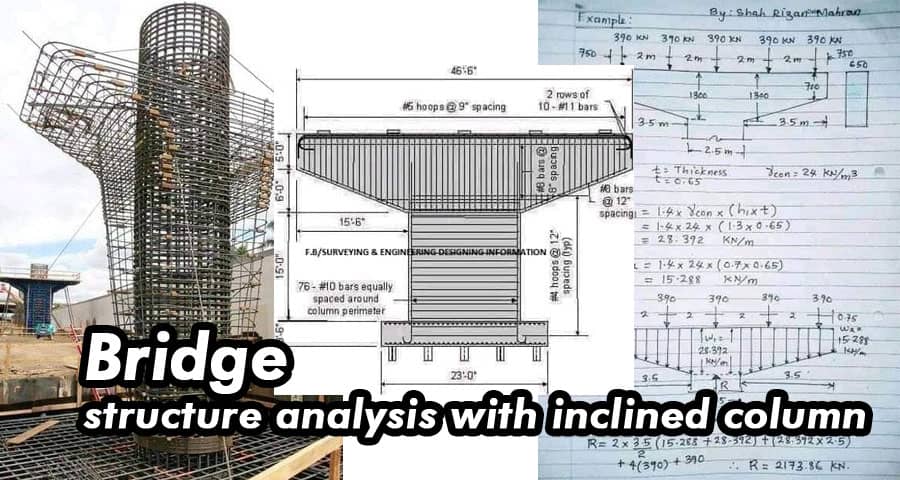Bridge structure analysis with inclined column calculation

Bridges are marvels of engineering, connecting distant points and facilitating the movement of people and goods. Understanding the intricacies of bridge structure analysis and inclined column calculation is crucial for ensuring their safety and efficiency.
Understanding Bridge Structure Analysis
Bridge structure analysis is the process of assessing the behavior and performance of bridge components under various loading conditions. It involves analyzing the forces, stresses, and deformations experienced by different parts of the bridge to ensure structural integrity and safety. Here's an overview of key aspects:
Types of Bridges
Bridges come in various types, each with its unique structural configuration and load-bearing mechanisms. Common types include:
- Beam Bridges: Simplest form, supported by beams or girders spanning between two abutments.
- Truss Bridges: Utilize triangular truss elements to distribute loads efficiently.
- Arch Bridges: Arch-shaped structures that rely on compression to support weight.
- Suspension Bridges: Feature cables suspended from towers, distributing loads to anchorages.
- Cable-Stayed Bridges: Cables attached directly to towers, supporting the bridge deck.
Understanding the type of bridge is essential for determining the appropriate analysis methods and considerations.
Load Analysis
Load analysis involves assessing the various forces exerted on a bridge, including dead loads (permanent weight of the structure), live loads (traffic, pedestrians), environmental loads (wind, seismic activity), and dynamic loads (impact from moving loads). By quantifying these forces, engineers can design bridges capable of withstanding anticipated loads without failure.
Structural Modeling
Structural modeling is the process of representing a bridge system using mathematical equations and computational tools. Advanced software allows engineers to create detailed digital models that simulate the behavior of bridge components under different loading scenarios. This enables precise analysis and optimization of bridge designs to meet performance requirements.
Finite Element Analysis (FEA)
Finite Element Analysis (FEA) is a powerful computational technique used to solve complex structural problems by dividing the bridge into smaller, manageable elements. By applying principles of continuum mechanics, FEA can accurately predict stresses, strains, and displacements within the bridge structure, aiding in design refinement and optimization.
Calculating Inclined Columns in Bridge Design
Inclined columns play a crucial role in supporting the weight of bridge decks and transferring loads to the foundation. Proper calculation of inclined columns is essential for ensuring stability and structural integrity. Here's how it's done:
Determining Load Distribution
Before calculating inclined columns, engineers must assess the distribution of loads across the bridge deck. Factors such as span length, traffic volume, and environmental conditions influence load distribution, impacting the design of inclined columns.
Analyzing Structural Forces
Once load distribution is determined, engineers analyze the structural forces acting on inclined columns, including axial compression, bending moments, and shear forces. This requires considering the geometry of the bridge, material properties, and boundary conditions.
Designing Inclined Columns
Based on structural analysis, engineers design inclined columns to withstand anticipated loads while maintaining stability and safety. Factors such as column geometry, reinforcement detailing, and construction materials are carefully considered to ensure optimal performance.
Construction Considerations
During construction, precise execution of inclined column design is critical to achieving the desired structural integrity. Quality control measures, proper material handling, and adherence to construction specifications are essential for successful implementation.
Implementing Advanced Analytical Techniques
In addition to traditional analysis methods, advancements in technology have led to the adoption of advanced analytical techniques for bridge structure analysis and inclined column calculation. These include:
- Computational Fluid Dynamics (CFD): CFD is used to simulate the behavior of fluids and gases within and around bridge structures, allowing engineers to assess the effects of wind, water flow, and other environmental factors on bridge performance. By incorporating fluid dynamics into structural analysis, engineers can design bridges that are more resistant to wind-induced vibrations and aerodynamic instability.
- Nonlinear Analysis: Nonlinear analysis accounts for the nonlinear behavior of materials and structural elements under extreme loading conditions. Unlike linear analysis, which assumes a linear relationship between loads and deformations, nonlinear analysis considers factors such as material yielding, geometric nonlinearity, and large displacements. This enables engineers to accurately predict the response of bridges to severe loading events, such as earthquakes and heavy traffic.
- Optimization Algorithms: Optimization algorithms are used to iteratively improve bridge designs by minimizing weight, material usage, or construction costs while meeting performance requirements. These algorithms leverage mathematical optimization techniques to search for the most efficient design solutions within specified constraints. By optimizing bridge designs, engineers can achieve significant improvements in structural efficiency and cost-effectiveness.
Embracing Innovation in Bridge Engineering
The field of bridge engineering is continually evolving, driven by technological advancements, innovative materials, and sustainable design practices. Engineers are increasingly embracing innovation to address emerging challenges and push the boundaries of bridge design and construction. Some notable trends include:
- Sustainable Materials: The use of sustainable materials, such as recycled steel, composite materials, and high-performance concrete, is becoming increasingly prevalent in bridge construction. These materials offer environmental benefits, reduced life cycle costs, and improved durability compared to traditional materials, contributing to the long-term sustainability of bridge infrastructure.
- Smart Bridge Technologies: Smart bridge technologies leverage sensors, actuators, and data analytics to monitor bridge health, detect structural abnormalities, and facilitate proactive maintenance. By integrating real-time monitoring systems into bridge infrastructure, engineers can identify potential issues before they escalate, prolonging the service life of bridges and enhancing safety for users.
- Prefabrication and Modular Construction: Prefabrication and modular construction techniques are revolutionizing bridge construction practices, enabling faster, more cost-effective project delivery. Off-site fabrication of bridge components allows for greater precision, quality control, and efficiency compared to traditional on-site construction methods, reducing construction time and minimizing disruption to surrounding communities.
Conclusion
Bridge structure analysis and inclined column calculation are integral aspects of bridge engineering, ensuring the safety, durability, and functionality of these vital infrastructure assets. By understanding the principles and methodologies outlined in this guide, engineers can design and construct bridges that meet the demands of modern transportation while prioritizing safety and efficiency.
